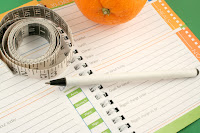It’s that time of year
again- the holidays are behind us and life is getting back to normal. But if you’ve already broken your new year’s
resolution to eat better and exercise more, don’t worry, you’re not alone! Even though they were set with good
intentions, your goals may not be
practical or easy to sustain. Setting
realistic resolutions and planning on how to carry them out with the help of a
registered dietitian can help you salvage your resolutions and get you back on
track.
One of the best ways
proven to help you eat healthier and consume fewer calories is to track what
you eat. Luckily, in the year 2013, it has never been easier! Using a food journal app on your smart phone
or tablet makes it quick and easy to write down what you eat. Searchable online databases now include
everything from generic foods to brand name restaurants so everything can be
added with the click of a button. Guess work with calories is frustratingly
inaccurate and often pushes people to stop tracking their eating. Finding the right app eliminates any guess
work.
How can tracking what you
eat help? Simply being more aware of what you are putting in your mouth can
help you eat better. It forces you to be more accountable for your choices and
think twice before making rash decisions. Accountability is a big driver
towards actually changing your habits and sticking to your health goals.
Food tracking can help you
see unhealthy patterns in your eating such as skipping meals or not taking time
out to enjoy them (for example “I thought I eat breakfast on most days of the
week when in fact it’s more like 2 times per week...”). It also forces you to be more honest with
yourself about the amount you eat (for example “Where did all the cookies go? I swear I ate only two last night!”).
Of course, food tracking
does require you to be somewhat accurate with your estimations of portion sizes
if you want a true picture of your eating habits. This is where it can become
time consuming. However, there is a very easy tool you can use to guess
portions- your hand! The palm of your hand is about 3oz, your fist is about 1
cup, two fingers about 1½ oz, and your whole thumb is about 1 tbsp. Start with
this easy trick and if you want more details, use measuring cups to get a
better eye for amounts.
An online site or app
tallying what eat can help you make healthy choices throughout the day. This is
the real advantage over old-school hand written journals. You can immediately
know how much you have eaten and compare it to what your body requires for the
rest of the day.
Also, rather than
labelling foods as good or bad, tracking will help you understand which foods
are dense in calories and which ones are less dense. This way you can chose what
you want to eat based on the portion sizes you want to consume. If you are
really hungry, eating a small handful of nuts may not satisfy you enough, so
you may turn to lighter foods such as fruit or yogurt to add volume.
Start with the
intention of tracking your food for a few days to get the ball rolling. It may
feel easier to start small then aspire to track a whole week. Once you get an
idea of where your habits stand in comparison to your needs, you can start
aiming at truly personalized healthy eating habits.
Check out these interesting online sites to get you started: www.eatracker.ca or www.myfitnesspal.com












No comments:
Post a Comment